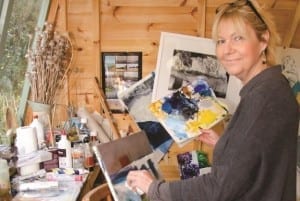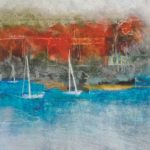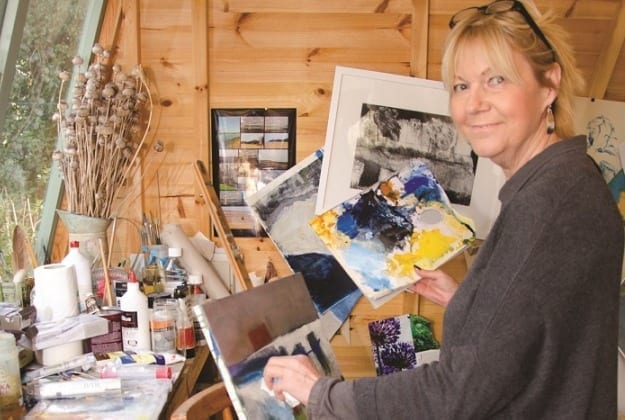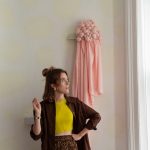 If you haven’t attended any exhibitions by the Isle of Wight Art Club, or popped into Burfields Antiques in Ventnor recently, you probably won’t have come across the art of Lorna Seaward.
If you haven’t attended any exhibitions by the Isle of Wight Art Club, or popped into Burfields Antiques in Ventnor recently, you probably won’t have come across the art of Lorna Seaward.
Her work is striking, extremely diverse, and often interprets familiar Isle of Wight landscapes in subtly textured collage with a clever use of atmospheric colour. Tracy Curtis has been to meet Lorna to find out more.
So why have we not seen more of Lorna’s work? It’s only been relatively recently that Lorna’s had the time to practice her craft regularly and gained the confidence to show it to others. After a brief foray with Art School when she was younger, her creative flare was put on the backburner as she married, moved to the Island in 1970 and brought up three, now grown up children who, incidentally, all have Lorna’s art on their walls. She smiles wryly, “They seem to like it, unless they’re just being kind.”
Around five years ago Lorna became a member of the Isle of Wight Art Club, which has been instrumental in the progression of her work. As Lorna explains, “A friend had suggested I join because they give you a chance to exhibit your work as a group. It was lovely to start getting back into the swing of things. The first exhibition I was involved in encouraged the viewing public to note down their favourite piece of art on display. Mine was chosen as the winner and subsequently got published in Leisure Painter Magazine. It really gave me the confidence to start thinking more seriously about selling my art. About two years ago I took some of my work down to Burfields in Ventnor because they deal in fine art and support local artists. The owner Jackie liked it, so now it’s sold there.”
When asked to describe her style, Lorna hesitates, “My work is varied; I don’t really know how to describe it. A lot of it is edging towards abstract, although the subjects are still generally recognisable. I don’t tend to do the same thing twice.” Jackie from Burfields agrees about the diversity of Lorna’s art, “What I love about her work is that I never know what she’s going to bring in next, but it always sells well.”
Lorna cites Joan Eardley, considered a Scottish artist, who painted rather abstract yet recognisable portraits and landscapes in the 1940’s – 60’s as an influence, adding that there are many Scottish artists she admires, “I think I tend to like them as their work has a gritty feel about it.”
She mainly works with acrylics; you can see the bold brush strokes in her paintings, although more recently she’s been using charcoals. Some of her latest work is collage, which is barely noticeable from afar, but close up reveals an amazing effect. Lorna continues “I like texture. I’ll sometimes tear up old paintings that I thought were rubbish, and play with lots of different bits, creating the collage from the parts that looked ok. Then I heavily work into it by painting or drawing over the top. My collages are a reflection of everything in my head, sometimes they’re drawn from areas in Brixham where I used to live combined with the Island, they end up looking nothing like a specific place, but that’s what I have in my mind.”
Although the colour palette Lorna uses is wide and often bright, she admits “I tend to be drawn towards browns and blues, which don’t necessarily go together, but I seem to be comfy with those colours.”
 She’s used many famous Isle of Wight landmarks as subjects, including The Needles, Carisbrooke Castle and The Duver, tending to return time and time again to the Islands cliffs and beaches for inspiration. Working in typical artist fashion from a shed at the bottom of the garden she admits, “I do have difficulty deciding on my subject sometimes, but I usually make sketches whenever I’m painting outdoors with the art group so I’ll go through those, ruminate for a bit, thinking about what to do, then work from them.”
She’s used many famous Isle of Wight landmarks as subjects, including The Needles, Carisbrooke Castle and The Duver, tending to return time and time again to the Islands cliffs and beaches for inspiration. Working in typical artist fashion from a shed at the bottom of the garden she admits, “I do have difficulty deciding on my subject sometimes, but I usually make sketches whenever I’m painting outdoors with the art group so I’ll go through those, ruminate for a bit, thinking about what to do, then work from them.”
In the future she wants to get more abstract. “It’s actually very difficult to do good abstract work with real feeling in it and I’m finding it tricky at the moment. Anyone can just do splodges, but to produce something people can respond to is the challenge.”
Lorna still views her art as a hobby with benefits. “If somebody buys a piece of my work, it’s not the money I get excited about, but the fact someone has liked one of my pieces enough to pay for it. That gives me a really good feeling.”
Visit Burfields to experience Lorna’s art up close; it really will add another dimension to your home.






